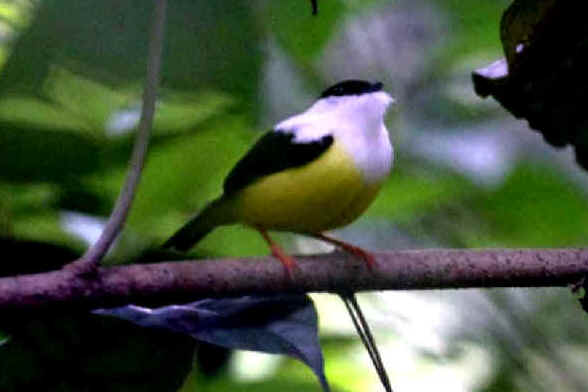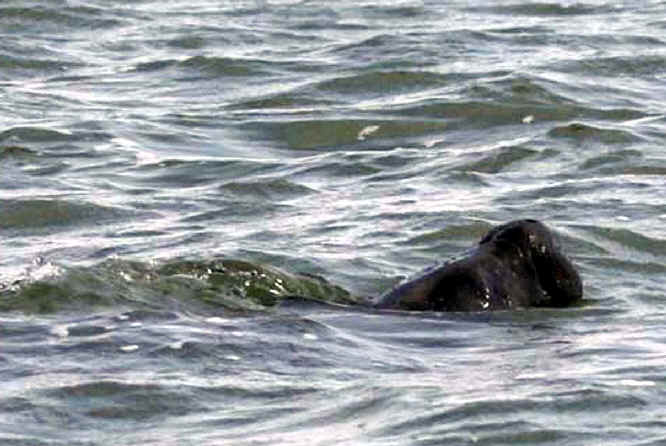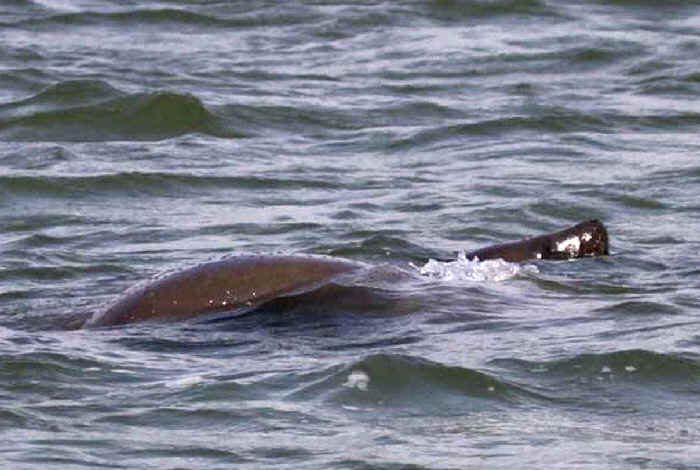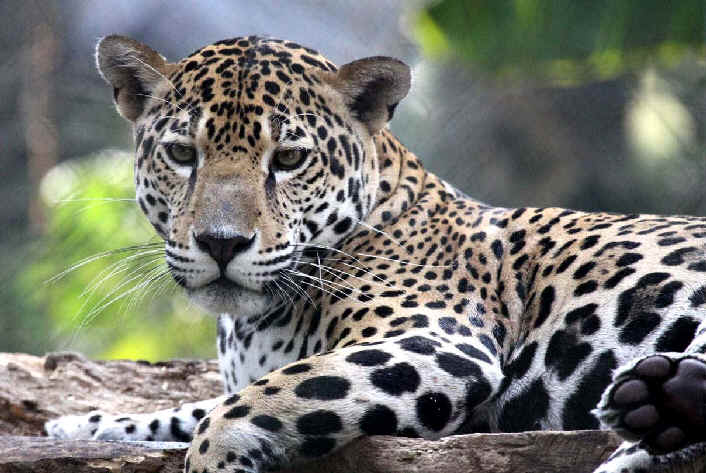
E-mail: font@focusonnature.com
Phone: Toll-free in USA 1-888-721-3555
or 302/529-1876
 |
PO
Box 9021, Wilmington, DE 19809, USA E-mail: font@focusonnature.com Phone: Toll-free in USA 1-888-721-3555 or 302/529-1876 |
THE FOCUS ON NATURE TOUR IN BELIZE
April 2011
"At
places such as Crooked Tree and Cotton Tree,
and with wildlife as small as Manakins, as large as Manatees"

Above: in a
forest in southern Belize, a White-collared Manakin
Below: in a bay in central Belize, the snout of a Manatee
(Both photos by Marie Gardner during the April 2011 FONT Tour in
Belize)

Links:
A Feature of Photos from the April 2011 FONT Belize Tour
Birds & Other Nature during the FONT Belize Tour in April 2011
A List of Belize Birds Mammals in Belize (with some photos)
Amphibians & Reptiles in Belize & Guatemala (with some photos)
Upcoming FONT Birding & Nature Tours in Central America
The following, relating to the FONT April 2011
Belize Tour, was
written by Armas Hill, the tour leader:
Upon our arrival at the airport
in Belize, for our April
2011 tour in that country, getting our vehicle at "Jabiru Auto
Rental" was truly an omen.
About an hour later, as we arrived at a place called
"Crooked Tree", and from the causeway, on the lagoon, we
saw as many as 25 Jabiru, at once!
During that day and the next, we estimated that we saw about 50 of the
large Jabiru storks, about half of what is said to be the population of
that bird in Belize.
And Belize has, certainly, the most Jabiru of any country in Central
America.
During a previous tour at Crooked Tree, it's
interesting to note that we saw no Jabiru, not a one. We had to go to
another place to see a pair, with young, at a nest. That tour was also in the
spring, but a notable difference in April 2011
was that it was drier than usual.
The lagoon at Crooked Tree, during our two days there, could be seen shrinking,
as the dryness and heat at the end of the dry season continued.
And as it shrank, that lagoon and the area were teeming with birds, thousands of
them. In addition to the dozens of Jabiru, there were hundreds upon
hundreds of Neotropic Cormorants, Limpkins, Snail Kites, Jacanas,
various egrets, herons, ibises, and other waterbirds.
Among them: Roseate Spoonbills, Wood Storks, terns,
sandpipers, grebes and ducks, including Blue-winged Teal
that would soon go north and Black-bellied Whistling Ducks that would
stay in the area if it did not dry up completely.
The fish and other food for the thousands of birds were concentrated in, and by,
the remaining shallow water. Small Talapia, by the score, could be seen
in the evening, leaping from and back into the
water.
We were told when we arrived at Crooked Tree that the water level was too low
for the boat-trip that we had planned to take to see the not-often-seen Agami
Heron. But we were not to be so easily deterred. "There must be another
way", and the next morning there was, when we rode in a hardy vehicle
across a lake-bed that was a mile wide and eight miles long. At times, in that
lake, there can be water as deep as 6 to 7 feet.
Then, beyond the lake, we continued in the vehicle through brush where there was
not even much of a walking trail until we came to the creek, where, upstream,
from quiet canoes, we saw, yes, the not-often-seen Agami Heron!
Also along that creek, birds that were with us included Boat-billed Herons,
Bare-throated Tiger Heron, and some kingfishers of various sorts
including the American Pygmy Kingfisher.
Prior to the creek, as we crossed the grassy lake-bed we encountered a cow that
had died, surrounded by dozens of Black Vultures. Atop that cow, there
was an adult nearly all-white King Vulture.
As we re-crossed that lake-bed, on our way out, we saw two adult King
Vultures.
Also, elsewhere, in the grass, there was a Dickcissel, pausing on its way
north, from South to North America. We don't see that species often in Central
America.
When we were venturing back into the brush for the canoe-ride along the creek, I
was reminded of some other such ventures "into the wild" during some
of our previous tours in Central America.
The first such venture that came to mind was of another boat-trip in the Darien
lowlands of eastern Panama, during which we also saw Agami Heron
and American Pygmy Kingfisher, in addition to Red-throated Caracara,
Crane Hawk, Green-and-rufous Kingfisher, and Greater Ani in
addition to other notable birds. And also, as we went along that stream in the
forest with local "Indians", we saw a big Boa Constrictor.
During another such remote venture along a small river in northern Guatemala,
near the Mexican border, I remembered us seeing a number of
"good birds"" in an area where loud Scarlet Macaws nested.
Swimming in the water by us, during that trip, there was a big Baird's Tapir.
In remote southern Costa Rica, in the La Amistad
International Park, near Panama, our ventures into the wild have been
not on boats, but instead land vehicles. There, where there were no people,
we've seen in trees toucans, bellbirds, and an unusual daytime Kinkajou.
Along a rushing stream, a Sunbittern.
Over the years, it has been wonderful to go in such a way, where not many go,
and I was glad to do it again in Belize in April
2011.
In all, during our time in April 2011 in the
Crooked Tree area of Belize, we found a nice
total of 118 species of birds.
Not only were the waterbirds plentiful, but we also saw a nice number of landbirds
in the forest and other habitats. Some were migrants, notably warblers on
their way north, but others were residents, including some "Yucatan"
specialties at the southern edge of their range including: the Yucatan Jay,
Yellow-lored Amazon, Red-vented Woodpecker, and Gray-throated
Chat. Nice to see, also, were Rufous-breasted Spinetail and a
Plain Xenops that maybe without realizing it, posed well for photographs as
it fed, at eye-level, on insects on a branch.
Fork-tailed Flycatchers, when they pose, are always nice birds to
see.
From where we had breakfast, we were easily distracted by the bight red male Vermilion
Flycatcher. Also red, there, in a nearby tree, was a Northern Cardinal,
also a resident at about the southernmost place where a Northern Cardinal would
be.
It was not the Northern Mockingbird that was there at the same time, but
the more-southerly Tropical Mockingbird.
After dark, at Crooked Tree, we enjoyed our
looks at Pauraques.
Mammals in that area after dark were Gray Four-eyed Opossums, seen
nicely, and the smallest of bats in Belize, the Proboscis Bat, weighing
only 5 grams. Other bats can weigh as much as 65 grams. Most are in between.
In northern Belize, we were, as noted, at Crooked Tree. In southern Belize, we
were at "Cotton Tree", the Cotton
Tree Lodge - a wonderful place to stay and to bird along the Moho
River. The tree is not "cotton" by the way, but rather a Belizean name
for the large Ceiba Tree.
Appearing like cotton, however, were the abundant Inga flowers in the
trees on the grounds. Inga flowers, at times, can be extremely attractive to
birds, particularly hummingbirds, but to other birds too.
Many hummingbirds were feeding on the Ingas in the trees. Most were Rufous-tailed
Hummingbirds. Most colorful were the male White-necked Jacobins. Also
at the Ingas, adding their colors, were migrating orioles and warblers,
feasting before traveling north.
There was yet more avian color at the grounds of the lodge, as an assortment of tanagers
was there too: the Passerini's, Golden-hooded, Yellow-winged, and Blue-gray.
Often heard was the Striped Cuckoo. Usually when it calls, it's hidden,
but not so when it was at the top of a tree outside our rooms.
Near the lodge, in the forest where we walked on a network of trails, we enjoyed
some excellent birding. We flushed (and saw!) a Little Tinamou. Seconds
later, we watched a Mayan Anthrush walking on the ground. The most
colorful denizen of the woods was the male White-collared Manakin. We saw
a few of them rapidly zipping about and then perched on horizontal branches
around us.
Other birds for us included: Chestnut-colored Woodpecker, Northern
Royal Flycatcher, Sulphur-rumped Flycatcher, Dusky Antbird,
Red-throated Ant-Tanagers, Yellow-throated Euphonia, and Yellow-billed
Cacique. Not bad for a walk in the forest.
Maybe the most pleasant sound was that of the Ivory-billed Woodcreeper,
with an alternate name, from that sound, of the Laughing Woodcreeper.
The loudest bird sound in the forest was from one of the smallest of its birds,
the White-breasted Wood Wren. We enjoyed seeing that small bird a few
times.
Another bird sound of the tour that's "so much of the tropics" was
that of the Montezuma Oropendola. The Keel-billed Toucans, up in
the trees, can sound so much like repetitive
insects.
In all, we found about 75 species of birds at the "Cotton
Tree". Among them, there were virtually no waterbirds,
only a Pied-billed Grebe that swan downriver.
Earlier mention was made of a bat that weighs only 5 grams. Another
mammal was seen during our April 2001
Belize Tour that is considerably larger, the West Indian Manatee.
Typically, an adult Manatee is 9 to 10 feet long, and weighs about 1,000
pounds. They can, however, be as long as 13 feet, and can weigh about 3,000
pounds (with females larger than males). As reference, 2,000 pounds is a
ton.
We went out one morning on a boat to a spot offshore favored by Manatees,
above, we were told, a warm spring under the water. A few Manatees were
there, about a half dozen.
We probably saw that many, usually singles, sometimes in pairs.
Because they have a slow metabolism, Manatees can only live in warm
water, usually occurring where is from 6 to 18 feet in depth.
The West Indian Manatees in Belize are a different subspecies than those
in Florida, being the "Antillean Manatee", Trichechus
manatus manatus.
In Florida, they migrate to warmer waters when the water temperature dips to
under 67 degrees F.
Elsewhere, those in Central America and in northern South America, does not need
to do such a migration as water is warm all year. There may be some movement
related to wet and dry seasons.
What we saw were Manatees coming to surface of the water to breathe. We
saw, at times, their snouts, their full heads, their backs, and their
paddle-like tails. They generally don't stay up for long, so sometimes they are
not easy to see well (but a few times we did).
And, though they may be hard to see well, they, assuredly, are more difficult to
photograph! But Marie Gardner did - during our April 2011 tour, as in the
photo below.

An Antillean Manatee in
Belize,
showing part of the head & back
A large resting Manatee can stay submerged for about 20 minutes.
Otherwise, and it varies by individual or the time of day, surfacing to breathe
can be every 3 to 4 minutes.
In the water, by using both their tail and flippers, the large animals are
incredibly capable of complex maneuvering, including somersaults, rolls, and
swimming upside-down.
A Manatee typically swims with up-and-down motions of its body and tail,
like a whale or dolphin. Although they typically swim at a speed of 2 to 6 miles
per hour, they have been known to do faster sprints.
During an average day, a Manatee spends 6 to 8 hours feeding, and from 2
to 12 hours sleeping. When resting, a Manatee can lie on the floor of the sea or
bay.
Typically, Manatees eat daily from 4 to 9 per cent of their body weight.
They are herbivores and can eat a variety of plants, but their favored food is
seagrass.
They have a flexible upper lip that they use to bring their food into their
mouth. They grab and tear the plant with their lips.
The Belizean name for the Manatee is "Sea Cow". They do
graze on seagrass as cows graze on grass and hay.
The West Indian Manatee, or "Sea Cow" is an endangered
species, that we considered ourselves fortunate to see as we
did.
Another mammal that is endangered, and for which Belize
is well known, is the Jaguar. Nearly everywhere in the country where
there is a post card rack, there's a photo of one.
Throughout our tour, nearly everywhere we went, people had stories about them.
In Central America, Belize is a stronghold (if such a thing exists) for the Jaguar.
Even though it is a small country (about the size of Massachusetts), Belize is a
country where wildlife, even large wildlife, such as Jaguar, Puma
("the Red Tiger"), and Tapir (the national animal) still
exist in fairly good numbers, and certainly more so than in other Central
American countries (even those famous for their "nature").
Partly, Belize is as good as it is in that
regard because its human population is low (less than 250,000), and partly
because it is said that about 70 per cent of the country is still forested.
A place in Belize that's well known for Jaguars is Cockscomb.
With serrated hills and pinnacles that rise up to 3,700 feet above the nearby
Caribbean, giving the place its name, the topography does resemble, in a way, a
rooster's skull.
With not quite enough precipitation to be a true "rain forest", the
rough terrain is covered with what is instead called a "moist tropical
forest".
With whatever the habitat is called, the Cockscomb
Basin was established in 1984 as the only designated sanctuary
anywhere for Jaguars. At first, it was a nearly 4,000 acre preserve. It
was expanded to over 100,000 acres in 1990s.
Now, it is the home to a roster (not a "rooster") of large
creatures such as tapir, peccary, deer, howler monkey, iguana, curassow,
and all 5 regional wild cat species: Jaguar, Puma, Ocelot, Jaguarundi, and
Margay.
When we visited Cockscomb in April
2011, we saw and heard a number of birds, but encountered none of the
large creatures just noted, even though we drove the road at a good time around
dusk.
It is difficult to cross paths with a Jaguar in the wild. We have done so
during 6 previous FONT tours: 3 in Brazil, 2 in Mexico, and 1 Guatemala. In
Belize, during a previous tour, we've come across fresh tracks.
But, this time, in Belize, we did enjoy an
encounter of sorts with a Jaguar. An animal that had been an orphan was
at a large enclosure at a place where we stayed called "Banana
Bank".
We spent some time observing the magnificent animal, named "Tika 2".
When we stayed at Banana Bank during our
first tour in Belize, back in 1992, "Tika 1" lived in that
enclosure, and did so for a number of years until it died of "old
age".
"Tika 2" resides now at Banana Bank
as there was not room for her at the Belize Zoo.
She's being well cared for, and seemed fine. Not minding, apparently, being
alone, as in the wild Jaguars are truly solitary animals.
As I said, at every place we went, there were stories, usually about encounters
with Jaguars. But at Banana Bank,
there was the animal - that was once a youngster at a place only 5 miles away.
Here at FONT we don't usually highlight captive animals. But now, as an
exception, here are some photos of "Tika 2":
